Input interpretation

di-p-toluoyl-D-tartaric acid monohydrate
Basic properties
O)([C@@](C(=O)C2=CC=C(C)C=C2)(C(=O)O)O)O.O InChI identifier | InChI=1/C20H18O8.H2O/c1-11-3-7-13(8-4-11)15(21)19(27, 17(23)24)20(28, 18(25)26)16(22)14-9-5-12(2)6-10-14;/h3-10, 27-28H, 1-2H3, (H, 23, 24)(H, 25, 26);1H2/t19-, 20-;/m1./s1/f/h23, 25H; InChI key | XVNKNFCMXHXIPO-GZJHNZOKSA-N](../image_source/79651f174265855bbcba6931e39665fe.png)
molar mass | 404.4 g/mol formula | C_20H_20O_9 empirical formula | O_9C_20H_20 SMILES identifier | CC1=CC=C(C=C1)C(=O)[C@@](C(=O)O)([C@@](C(=O)C2=CC=C(C)C=C2)(C(=O)O)O)O.O InChI identifier | InChI=1/C20H18O8.H2O/c1-11-3-7-13(8-4-11)15(21)19(27, 17(23)24)20(28, 18(25)26)16(22)14-9-5-12(2)6-10-14;/h3-10, 27-28H, 1-2H3, (H, 23, 24)(H, 25, 26);1H2/t19-, 20-;/m1./s1/f/h23, 25H; InChI key | XVNKNFCMXHXIPO-GZJHNZOKSA-N
Structure diagram
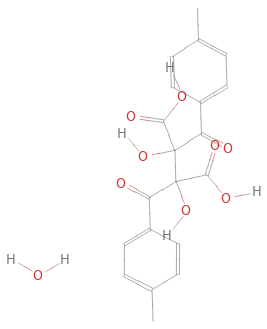
Structure diagram
Quantitative molecular descriptors
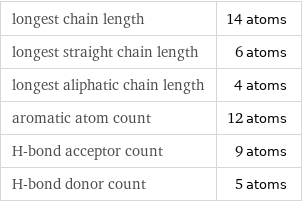
longest chain length | 14 atoms longest straight chain length | 6 atoms longest aliphatic chain length | 4 atoms aromatic atom count | 12 atoms H-bond acceptor count | 9 atoms H-bond donor count | 5 atoms
Elemental composition

Find the elemental composition for di-p-toluoyl-D-tartaric acid monohydrate in terms of the atom and mass percents: atom percent = N_i/N_atoms × 100% mass percent = (N_im_i)/m × 100% Plan: • Write the chemical formula and gather atomic masses from the periodic table. • Determine values for N_i, m_i, N_atoms and m using these items. • Finally, compute the percents and check the results. Write the chemical formula: C_20H_20O_9 Use the chemical formula, C_20H_20O_9, to count the number of atoms, N_i, for each element and find the total number of atoms, N_atoms: | number of atoms O (oxygen) | 9 C (carbon) | 20 H (hydrogen) | 20 N_atoms = 9 + 20 + 20 = 49 Divide each N_i by N_atoms to calculate atom fractions. Then use the property that atom fractions must sum to one to check the work: | number of atoms | atom fraction O (oxygen) | 9 | 9/49 C (carbon) | 20 | 20/49 H (hydrogen) | 20 | 20/49 Check: 9/49 + 20/49 + 20/49 = 1 Compute atom percents using the atom fractions: | number of atoms | atom percent O (oxygen) | 9 | 9/49 × 100% = 18.4% C (carbon) | 20 | 20/49 × 100% = 40.8% H (hydrogen) | 20 | 20/49 × 100% = 40.8% Look up the atomic mass, m_i, in unified atomic mass units, u, for each element in the periodic table: | number of atoms | atom percent | atomic mass/u O (oxygen) | 9 | 18.4% | 15.999 C (carbon) | 20 | 40.8% | 12.011 H (hydrogen) | 20 | 40.8% | 1.008 Multiply N_i by m_i to compute the mass for each element. Then sum those values to compute the molecular mass, m: | number of atoms | atom percent | atomic mass/u | mass/u O (oxygen) | 9 | 18.4% | 15.999 | 9 × 15.999 = 143.991 C (carbon) | 20 | 40.8% | 12.011 | 20 × 12.011 = 240.220 H (hydrogen) | 20 | 40.8% | 1.008 | 20 × 1.008 = 20.160 m = 143.991 u + 240.220 u + 20.160 u = 404.371 u Divide the mass for each element by m to calculate mass fractions. Then use the property that mass fractions must sum to one to check the work: | number of atoms | atom percent | mass fraction O (oxygen) | 9 | 18.4% | 143.991/404.371 C (carbon) | 20 | 40.8% | 240.220/404.371 H (hydrogen) | 20 | 40.8% | 20.160/404.371 Check: 143.991/404.371 + 240.220/404.371 + 20.160/404.371 = 1 Compute mass percents using the mass fractions: Answer: | | | number of atoms | atom percent | mass percent O (oxygen) | 9 | 18.4% | 143.991/404.371 × 100% = 35.61% C (carbon) | 20 | 40.8% | 240.220/404.371 × 100% = 59.41% H (hydrogen) | 20 | 40.8% | 20.160/404.371 × 100% = 4.986%
Elemental oxidation states

The first step in finding the oxidation states (or oxidation numbers) in di-p-toluoyl-D-tartaric acid monohydrate is to draw the structure diagram. Next set every oxidation number equal to the atom's formal charge: In di-p-toluoyl-D-tartaric acid monohydrate hydrogen is not bonded to a metal with lower electronegativity, so it will have an oxidation state of +1. Any element bonded to hydrogen gains the bonding electrons, decreasing their oxidation state by 1 for every bond: With hydrogen out of the way, look at the remaining bonds. There are 8 carbon-oxygen bonds, and 21 carbon-carbon bonds. For each of these bonds, assign the bonding electrons to the most electronegative element. First examine the carbon-oxygen bonds: element | electronegativity (Pauling scale) | C | 2.55 | O | 3.44 | | | Since oxygen is more electronegative than carbon, the electrons in these bonds will go to oxygen. Decrease the oxidation number for oxygen in every highlighted bond (by 1 for single bonds, 2 for double bonds, and 3 for triple bonds), and increase the oxidation number for carbon accordingly: Next look at the carbon-carbon bonds: element | electronegativity (Pauling scale) | C | 2.55 | C | 2.55 | | | Since these elements are the same the bonding electrons are shared equally, and there is no change to the oxidation states: Now summarize the results: Answer: | | oxidation state | element | count -3 | C (carbon) | 2 -2 | O (oxygen) | 9 -1 | C (carbon) | 8 0 | C (carbon) | 4 +1 | C (carbon) | 2 | H (hydrogen) | 20 +2 | C (carbon) | 2 +3 | C (carbon) | 2
Orbital hybridization
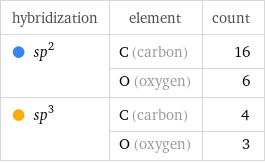
hybridization | element | count sp^2 | C (carbon) | 16 | O (oxygen) | 6 sp^3 | C (carbon) | 4 | O (oxygen) | 3
Structure diagram
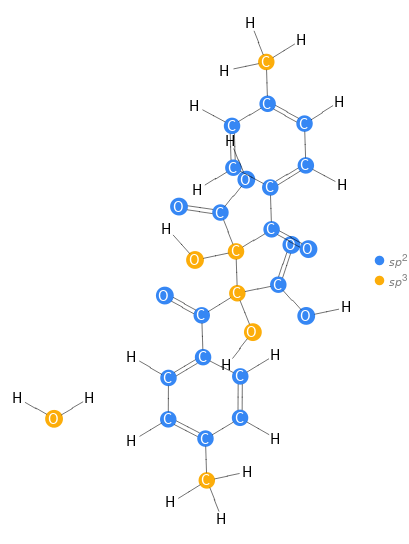
Orbital hybridization Structure diagram
Topological indices
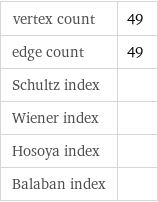
vertex count | 49 edge count | 49 Schultz index | Wiener index | Hosoya index | Balaban index |